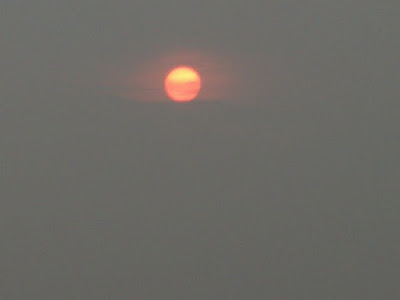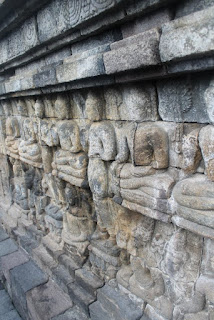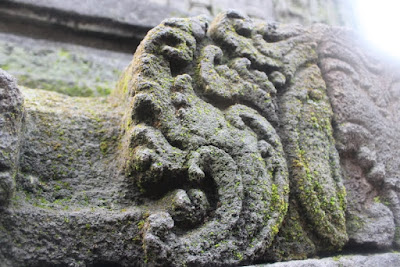While in Jogja, it's practically required that you go see
Borobudur, and for good reason. It was amazing. Here's my take on it, although I hope the ladies will jump in with their remembrances, too.
A little bit of background:
Borobudur is a massive, intricate Buddhist temple in the same vein as
Angkor Wat. Originally built sometime between 750 and 850 AD (300 years before Angkor Wat) as a shrine to Buddha and as a site for pilgrimage, then temple was abandoned and forgotten in the 14th century as Buddhism and Hinduism on Java declined (and Islam became prominent), the jungle and volcanic ashes swallowed it up. Eventually it was unearthed when
Sir Thomas Stamford Raffles, the then British ruler of Java and ultimately the founder of Singapore, caught wind of it from the locals. It's now a
UNESCO World Heritage site.
We decided to hit up Borobudur by spending one night at the hotel closest to the temple,
Manohara, which provided us with access to their sunrise tour of the temple before all of the other tourists arrived. Definitely worth it!
The night before we watched a 40 minute video, an ancient relic from approximately 1983 (
when Borobudur's restoration was completed), that gave us some background on the temple and relayed some of the fables we might encounter depicted in the
bas-relief carvings all over the temple. We're still trying to decipher the meaning of some of the stories.
For the sunrise tour, we woke up at 4:30 am bleary-eyed and a little bit out of it, donned these spiffy Borobudur batik sarongs, turned on our flashlights and made the walk of a few hundred yards over to the temple.
Climbing Borobudur's steep and purposefully uneven steps in the pre-dawn dark was a challenge, but the view from the top was totally worth it!
Watching the sunrise from the temple was absolutely amazing. It was misty/foggy that morning and very quiet until the roosters started crowing and the early call to prayer came rolling through the hills from various local mosques. Hearing the call to prayer while sitting on this ancient Buddhist temple really made you think about what a complicated history Indonesia has and how it's been influenced by so many different cultures and religions.
The
structure of Borobudur is one large stupa (shrine for the Buddha) in the shape of a big square
mandala. It had 9 platforms, the lower 6 of which are square and the upper 3 of which are circular. The upper platform has 72 mini bell-shaped stupas, which you see in profile in these photos. Originally, each of these stupas had a
statue of Buddha in it. Now, unfortunately, some of the statues are missing all together, and many are missing their heads due to looting (
some of which was government authorized looting, essentially).
Pensive Liz contemplates life, religion, enlightenment... and breakfast.
In the photo below you can begin to see the holes in each of the mini-stupas, which allow you to look in an see the
Buddha statue. On the lower levels of the temple, all of the holes are diamond shaped, whereas on the upper levels, they are square shaped.
My feet and sarong.
Timed self-portrait: FAIL.
You can see the Buddha sitting inside of this topless stupa:
Sweaty and sleepy:
Oh hai, Buddha! You are looking well this morning!
A view down the steps, through one of the main gateways.
Sun peeking out from behind the thick mist:
A large banner depicted the efforts made to restore the Borobudur temple after the 2010 Mt. Merapi eruption, which included dry cleaning, wet cleaning, and dismantling the floor to clean the drainage system, among other things.
Liz touching the hand of the "lucky-in-love" Buddha. Meghan refused on the premise that hand-touching is icky.
A lion gate guardian:
The
theory is that Borobudur was originally designed as both a shrine and a pilgrimage site. Pilgrims to the site walk around each level of the temple towards the top, always clockwise with the temple on their right, a specific number of times on each platform, in order to contemplate all of the narratives and images in the over 2,760 bas-relief carvings (covering 2,500 square meters and a length of 6 km!). Each of the levels is meant to represent a stage of
enlightenment.
Here are some looks down the long pathways, with the intricate bas-relief carvings on both sides:
We overheard a guide saying that he has noticed a sharp increase in the growth of moss/mold on the temple itself since
the acidic ash of the 2010 volcanic eruption covered it. He thought that perhaps the acid broke down whatever natural coating the stone had to protect itself:
Buddha, checking out the misty mountain tops:
The ladies making their way down the steep steps of Borobudur:
A view of the temple from the ground. Massive!
A view from the temple of the gardens surrounding it. If you look closely in the foreground of the photo, you'll see the early-bird trinket salesmen, eager to pounce on us as we walked back to the hotel in order to provide us with "yes, special morning price, yes!" Luckily, since we did the sunrise tour, we missed the masses of "
persistent touts" who harass tourists later in the day.
Map depicting the Borobudur site from above:




















































































